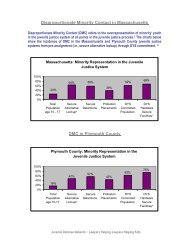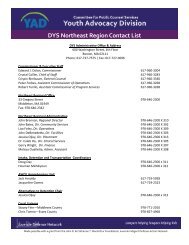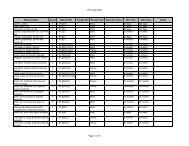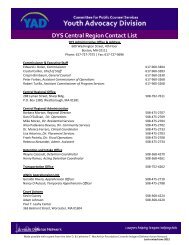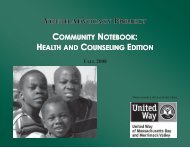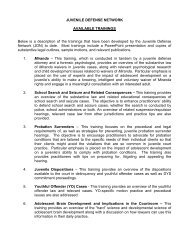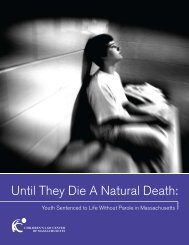States rethink 'adult time for adult crime' - the Youth Advocacy Division
States rethink 'adult time for adult crime' - the Youth Advocacy Division
States rethink 'adult time for adult crime' - the Youth Advocacy Division
You also want an ePaper? Increase the reach of your titles
YUMPU automatically turns print PDFs into web optimized ePapers that Google loves.
Teen Brains on Trial: Science News Online, May 8, 2004<br />
Using magnetic resonance imaging (MRI) scanners to probe <strong>the</strong> brains of<br />
healthy teenagers and young <strong>adult</strong>s, Elizabeth R. Sowell of <strong>the</strong> University of<br />
Cali<strong>for</strong>nia, Los Angeles (UCLA) and her colleagues reported in 1999 that<br />
myelin, <strong>the</strong> fatty tissue around nerve fibers that fosters transmission of<br />
electrical signals, accumulates especially slowly in <strong>the</strong> frontal lobe.<br />
The late phase of myelin <strong>for</strong>mation, occurring in teenagers, provides a neural<br />
basis <strong>for</strong> assuming that teens are less blameworthy <strong>for</strong> criminal acts that<br />
<strong>adult</strong>s are, Gur says. There's no way to say whe<strong>the</strong>r, <strong>for</strong> example, an<br />
individual 17-year-old possesses a fully mature brain. But <strong>the</strong> biological age of<br />
maturity generally falls around age 21 or 22, in Gur's view.<br />
Although 18 years old represents an arbitrary cutoff age <strong>for</strong> receiving a capital<br />
sentence, it's preferable to 17, according to Gur.<br />
"These brain data create reasonable doubt that a teenager can be held<br />
culpable <strong>for</strong> a crime to <strong>the</strong> same extent that an <strong>adult</strong> is," agrees neuroscientist<br />
J. Anthony Movshon of New York University.<br />
Fear factor<br />
Abigail A. Baird of Dartmouth College in Hanover, N.H., also suspects that<br />
delayed neural development undermines teens' judgment in ways that affect<br />
<strong>the</strong>ir legal standing. "There's no reason to say <strong>adult</strong>hood happens at age 18,"<br />
Baird says. Unlike Gur, however, she estimates that <strong>the</strong> brain achieves<br />
maturity at age 25 or 26.<br />
A 1999 investigation led by Baird and Deborah Yurgelun-Todd of Harvard<br />
Medical School in Boston raised <strong>the</strong> possibility that certain characteristics of<br />
teens' brains make it difficult <strong>for</strong> <strong>the</strong>m to recognize when o<strong>the</strong>r people are<br />
scared. They tested 12 teenagers, ages 12 to 17. A functional magnetic<br />
resonance imaging (fMRI) scanner measured changes throughout<br />
participants' brains in blood flow, which studies have indicated reflect dips and<br />
rises in neural activity. As <strong>the</strong> teens briefly viewed and identified fear in<br />
pictures of people who had intentionally tried to look scared, <strong>the</strong> researchers<br />
observed marked increases in activity of an almond-shaped inner-brain<br />
structure called <strong>the</strong> amygdala.<br />
Neuroscientists suspect that <strong>the</strong> amygdala is important <strong>for</strong> learning to attach<br />
emotional significance to facial expressions and o<strong>the</strong>r stimuli. However, <strong>the</strong><br />
results of Baird and Yurgelun-Todd indicated that <strong>the</strong>re may not be a simple<br />
relationship between amygdala activity and accurate face reading.<br />
The teen volunteers—all with active amygdalas—incorrectly identified one in<br />
four fear expressions, usually labeling <strong>the</strong>m as angry, sad, or confused.<br />
In an ensuing fMRI study directed by Yurgelun-Todd, 16 participants ages 12<br />
to 17 also erred frequently when labeling <strong>the</strong> emotion on fearful faces. Those<br />
less than 14 years old answered incorrectly about half <strong>the</strong> <strong>time</strong> and yet<br />
showed <strong>the</strong> most amygdala activity, while older teens made fewer errors and<br />
displayed less activity in <strong>the</strong> amygdala and more in <strong>the</strong> frontal lobes than <strong>the</strong><br />
younger participants did.<br />
Previous studies had found that, when given <strong>the</strong> same task, <strong>adult</strong>s label most<br />
fearful expressions correctly and exhibit much more activity in <strong>the</strong> frontal<br />
lobes than in <strong>the</strong> amygdala.<br />
file:///L|/JDN/Brain%20Resources/Brain%20Development/Mailing%20Packet/10.%20Teen%20Brains%20on%20Trial.htm (3 of 9)8/16/2006 4:45:04 PM





